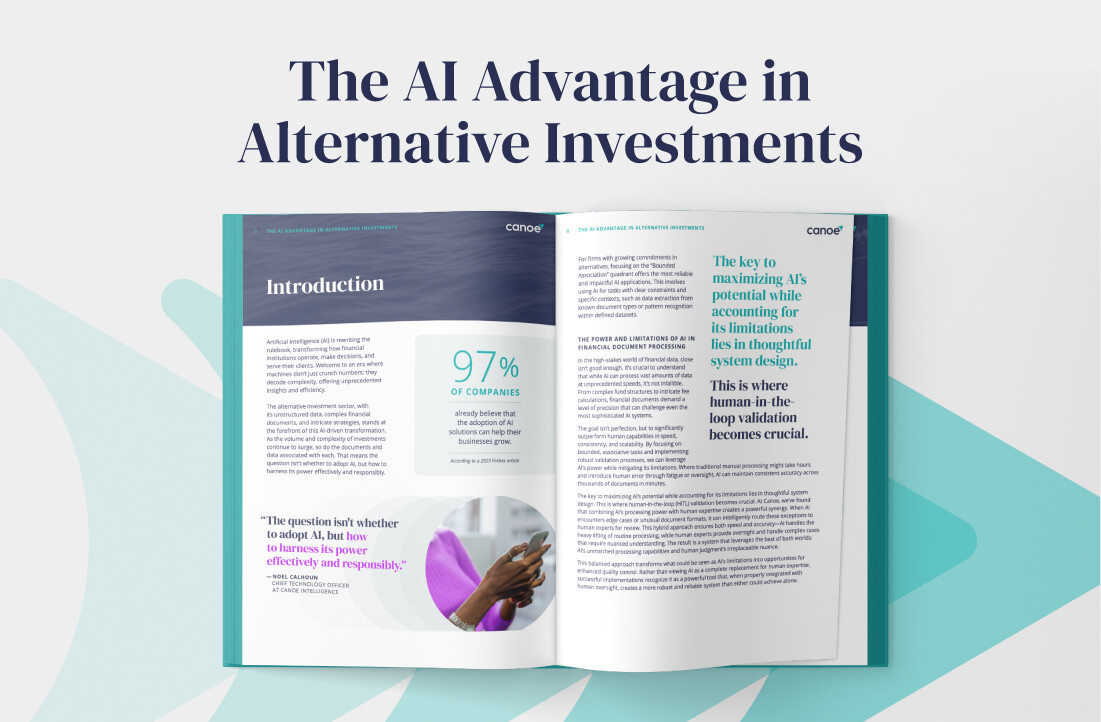Canoe Thought Starter: Change Management’s Role in a New Tech Implementation
Canoe Thought Starters is a blog series that explores timely topics for investors interested in alternative assets. Designed as thought exercises to drive conversations within your firm, these discussions are inspired by our recent interactions with clients, prospects, and influencers in the industry. This month, we are discussing change management: What is it, and how can it set you up for success in adopting new technology?
Introduction
In the digital age, technology adoption and evolution are two key factors in any organization’s success and longevity. However, the process of evaluating and ultimately implementing that technology can be even more important. Without careful planning, stakeholder engagement, and effective communication, the adoption of new technology can be rendered irrelevant. An effective change management plan can, in practice, reduce the amount of effort required over time, as contingencies are planned for and the project team is more prepared to take action instead of scrambling to react.
In short, managing a new technology implementation is critical. Here, we will explain what change management is, what it looks like in the context of financial services, and what role it can play in your organization’s long-term success.
Understanding The Role of Change Management in a New Technology Implementation
Change management is the process of preparing, supporting, and guiding individuals, teams, and organizations to adopt new technologies, processes, and behaviors more effectively for the long term. In the financial services industry, where standards for alternative investments are few and far between, change management is an even more critical factor in a successful implementation. Before an implementation can take place, you must have a strong foundation for change, especially since alternative investment operations and workflows tend to be more complex than those associated with traditional asset management. Effective change management can help alternative asset managers:
- Understand the impact of a change on your operations.
You need to assess how the new technology will affect your operations, including the workflows involved in managing your data and reporting on your alternative investments. By doing so, you can identify pain points, bottlenecks, and inefficiencies that the new technology can (and hopefully will) address, as well as potential challenges and risks associated with the implementation process. This impact assessment will help you better prepare for the transition and develop a comprehensive implementation plan.
- Engage stakeholders and gain organizational buy-in.
By effectively communicating the benefits of the new technology, addressing concerns and resistance to change, and building a sense of collaboration among all stakeholders, these individuals will better understand their role in your implementation and how the new technology will affect their day-to-day work. It will also help them become a champion of your new software and teach them how to proactively address any issues they may encounter.
- Accurately define project scope and adequately allocate resources.
Assignment of responsibilities and ownership, alongside validation that resource capacity actually exists, is often an assumption made rather than an active exercise performed. To stay on schedule, take a primary role in scoping and resource planning, and diligently review project scope before approval. Effective project planning and management have an undeniable impact on the perceived level of effort required by individual stakeholders, progress toward milestones, and clarity over deliverable ownership.
- Monitor progress and address issues by tracking key performance indicators (KPIs) and identifying areas for improvement.
Before the project begins, you need to be clear about your objectives and intended business results. After the implementation is complete, you must continue to track KPIs to understand the effectiveness of the new technology so that your firm can adapt as needed to combat any concerns or resistance that arise. By setting these indicators ahead of time, you know what to look for later down the road. The implementation deliverable is related to your ROI but is not the only contributing factor.
Common Challenges Faced in an Implementation
Each implementation will be different – whether it be the stakeholders involved or the outcomes desired. Fortunately, the challenges faced typically fall into one of a few common buckets. An effective change management plan should be designed to consider each of the areas and offer preemptive solutions to mitigate any potential fallout.
- Project management: Implementing any new technology requires effective project management, both on the vendor side and internally. You need to ensure that your vendor has the expertise to manage the project successfully and that your organization is equipped with the resources necessary to make the project happen as outlined in the implementation plan.
- Resistance to change: Your team may be resistant to change as they are likely comfortable with the existing processes and may not see the benefits of switching to new technologies. Involving them in the change management process as a stakeholder will help them to both understand the new tech and how it will impact their day to day.
- Cultural shift: Depending on its scope, the implementation of new technology may require a cultural shift within the organization. Certain teams may need to change their work habits as a result of the updated workflow and embrace new ways of working introduced by the technology.
- Deprecating legacy workflows: The process you’re using today is designed around the lack of a technology solution. With new software in place, you need to deprecate the programmatic workflows in order to cut over to the new process. This may be a rather involved planning process, but it pays off in the long term.
- Stakeholder assignment: Identifying who is going to own the new technology post-go-live and understanding the scope of that ownership are critical decisions to be made. Ideally, you will want to assign ownership to a person or group that is tech-savvy.
- Deployment resourcing: Alongside assigning an “owner” stakeholder, resourcing for deployment is a common missed factor. With projects passed along from a salesperson, you may lack a prescriptive indication of the scope for deployment. Ask the right questions to understand what is involved, and then actually make sure that you’re set up to make it happen.
- Role reconfiguration: There is often a gap between the person or the team who performs your existing workflow manually and those most likely to be considered your “tech-savvy owner.” Some adjustments will likely be required based on who is expected to use the tool and manage the workflow going forward.
- Technical expertise: Your employees may not have the necessary technical skills to use new technologies, especially if they are accustomed to performing their entire workflow manually. In any new implementation, training and support should be factored into the project plan to ensure proficiency.
- Security risk: New technologies may introduce new security risks, so it’s important to first ensure that your new vendor has appropriate security measures in place to protect your data. For more information on how to evaluate security in a new vendor evaluation, visit our data security considerations blog.
Preparing for Change: Building a Foundation for Success
To adequately prepare for a transition to a new technology, you must assess your current workflows and identify areas for improvement. Since workflows surrounding alternative investments are typically quite complex, lack standardization, and are performed manually, this evaluation and preparation process can be challenging but is necessary in order to plan for a smooth transition. You need to consider the complexity of investment structures and data sources, the unique and disparate nature of reporting and document retrieval processes, and how the new technology will impact – or eliminate – your existing processes.
What does this look like? We’ve prepared a to-do list framework to help you figure this out. Ultimately, the plan should be tailored to your firm’s specific needs, but we hope this is a helpful starting point.
In addition, you should also consider developing a comprehensive implementation plan, ideally in partnership with the tech provider, that outlines timelines, milestones, and KPIs. These steps will help ensure the implementation goes smoothly and stays on track. On top of that, it’s also important to figure out how you will engage stakeholders and gain their buy-in, as a successful implementation will only go so far without an equally successful adoption. As such, your plan should communicate the benefits of the new technology and address anticipated concerns and reasons for resistance to change.
Conclusion
In essence, an effective change management process is essential to the implementation of new technology at any company. For alternative investors specifically, it becomes a critical factor in their ability to remain competitive in a rapidly evolving market. With new opportunities arising in the space every day, your organization’s ability to understand how to plan for and manage this type of change can have a significant impact on the success of the implementation.
Canoe has supported more than 225 alternative investors and allocators through the process of implementing our technology. Our successful client implementations are the result of our comprehensive change management planning process, which we undertake with each new client prior to their implementation. To learn more about Canoe, please contact us or request a demo.
Keep reading: in the next blog post in this series, we share a deep dive discussion on the implementation process illustrated by Canoe client examples!




